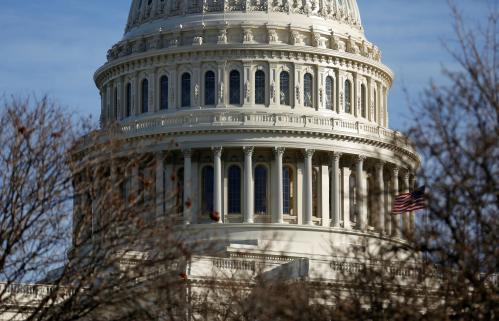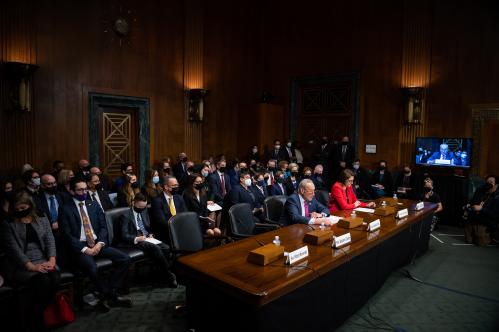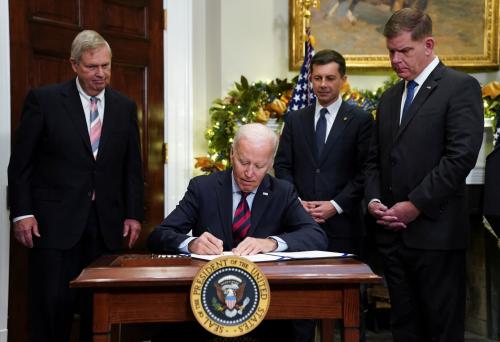This report is part of the Series on Regulatory Process and Perspective and was produced by the Brookings Center on Regulation and Markets.
According to prevalent media accounts, President Trump is not just behind his predecessors in staffing federal agencies, but far behind. The Washington Post reported last week that his own cabinet is “growing exasperated at how slowly the White House is moving.”
While there is disagreement as to the primary causes – the White House’s process for selecting officials versus the Senate’s review – alarm bells are ringing about the consequences. Most observers doubt that the new administration can achieve its policy objectives without its team in place. But some also worry about whether the government can function well, separate from partisan policy changes, with so many openings. The head of the Partnership for Public Service recently compared acting officials, who staff many of the unfilled positions, to “substitute teachers,” who are not “treated super well by the class because they don’t view that the substitute teacher has real authority.” I offer four points to consider in assessing the Trump administration’s progress at this stage.
1. Just How Far Behind is the Trump Administration?
Using data from congress.gov on all submitted non-routine civilian agency and judicial nominations to the Senate in the first 100 days (from January 20 to April 29), I compare the progress of President Trump’s administration against his five most recent predecessors.1 In short, his administration is the slowest of the last six, both in making nominations and getting Senate confirmations, but it does not lag all that far behind the record of the George W. Bush administration in this defined period.
The figure above and chart below provide the total number of submitted nominations in the first 100 days and the number of those nominations confirmed by the 100th day for Presidents Reagan, George H.W. Bush, Clinton, George W. Bush, and Trump.2These totals include both agency and judicial nominations (the latter, which cover both Article III and non-Article III courts, are also noted below in parentheses). President George H.W. Bush saw one nomination voted down and withdrew another nomination in the period, while Presidents Clinton, Obama, and Trump formally withdrew two, three, and three nominations, respectively.
| Table 1: Number of submitted and confirmed nominations in the first 100 days | ||||||
|---|---|---|---|---|---|---|
| President | Number of nominations | Number confirmed | ||||
| Reagan | 154 (2) | 97 (2) | ||||
| Bush 41 | 102 (6) | 50 (0) | ||||
| Clinton | 177 (1) | 49 (0) | ||||
| Bush 43 | 87 (2) | 35 (0) | ||||
| Obama | 196 (5) | 70 (0) | ||||
| Trump | 75 (3) | 28 (1) | ||||
| *The numbers in parentheses represent judicial nominations to both Article III and non-Article III courts. | ||||||
The number of Senate-confirmed positions does vary over this period, starting at over 1,000 and now resting at 1,242 positions.3 It is therefore critical to keep in mind that no recent president had filled more than ten percent of the total number of Senate-confirmed agency slots with confirmed appointees by the 100th day. To be fair, some of these positions (almost always in independent regulatory commission and boards, like the Federal Communications Commission) are not open to be filled at the start of an administration as individuals are serving terms that extend beyond inauguration. In addition, some of the Senate-confirmed positions are not tied to important policymaking duties. Nevertheless, even the presidents fastest in staffing agencies in the initial months have not filled any meaningful number of important jobs.
Table 2 breaks down the agency nominations by the type of position for each of these presidents.4
| Table 2: Agency nominations by type of position | ||||||
|---|---|---|---|---|---|---|
| Position | Reagan | Bush 41 | Clinton | Bush 43 | Obama | Trump |
| Secretary | 16 | 13 | 15 | 14 | 16 | 18 |
| Deputy Secretary | 8 | 8 | 11 | 7 | 14 | 8 |
| Under Secretary | 16 | 12 | 13 | 9 | 19 | 6 |
| Assistant Secretary | 48 | 22 | 57 | 25 | 59 | 6 |
| Administrator | 10 | 3 | 8 | 5 | 9 | 3 |
| IRC Member | 6 | 0 | 4 | 3 | 9 | 4 |
2. The Deceptive Allure of the 100-Day Mark
The 100-day mark is deceptive for several reasons. To start, some presidents may try to game it. The Senate received 30 nominations from President Clinton on the 100th day. Yet, 62 nominations from President George W. Bush arrived on the 101st day and therefore are not reflected in the totals used for comparisons.
More important, given the costly transition from campaigning to governing in the early months of an administration, the 100-day point is not a good predictor of future staffing. In an earlier study on executive agency staffing (examining a smaller set of positions with a different data source), I found that although President Obama had filled (with confirmed appointees) many more top agency jobs than Presidents George W. Bush (who had a slow start) and Clinton 100 days in, all three had similar numbers of positions filled at the one-year mark. In addition, because President Obama had more executive agency jobs to staff than his two predecessors, his first-year percentage record was only 64 percent, compared to 74 and 70 percent for Bush and Clinton.
We need to keep watching and assess the scope of hired agency officials at the end of 2017. And then we need to remain vigilant well after that. The median Senate-confirmed leader stays only 2.5 years, producing openings in the middle and the end of an Administration. In many ways, commitment to agency staffing is most heavily tested in the final two years of an administration.
3. Cautious Optimism Going Forward
The sky is not falling with respect to the current administration’s staffing of Senate-confirmed positions in federal agencies. There are several reasons for cautious optimism. To begin, the process takes time, but party politics and recent changes to the Senate’s rules favor this president. Like Presidents Reagan, Clinton and Obama (and unlike both Presidents Bush), President Trump has a Senate controlled by his party for at least his first two years. And unlike all five of his most recent predecessors, his initial selections do not require 60 votes to move to a confirmation decision. In November 2013, Senate Democrats changed the chamber’s rules to allow a simple majority to cut off debate. While it is true that confirmation delays increased the year after the change (when Democrats still controlled the Senate) as Republicans turned to mechanisms to slow down the process, more agency nominations were confirmed.
In addition, President Trump does have some people in place, including a few who consumed valuable Senate time. He had a complete cabinet one day before President Obama did, with his second nominee for secretary of labor confirmed on April 27. Because Senate Republicans refused to vote on Judge Garland, President Trump had the rare opportunity to fill an open Supreme Court seat in his first 100 days, which took Senate time away from agency nominations.
But more important, if the administration’s statements are true, there are considerable nominees in the pipeline. Although the Washington Post focused on the consternation of Trump’s cabinet secretaries, several statements from its report are more reassuring. Near the end, the article reports that “White House officials said they have given preliminary approval to 250 job candidates who are now undergoing vetting by the FBI and the Office of Government Ethics before being nominated and sent to the Senate for confirmation.” Between April 30 and the start of the August Senate recess in his first year, President Obama submitted 243 agency nominations to the Senate. A bit earlier but far beyond the lead, the article notes that according to a spokeswoman for the Transportation Department, “the department is about halfway toward filling its vacancies.” That is remarkable three months in, though it may not be representative (given that Secretary Chao has hired someone to help her with staffing).
There are, of course, some concerns unique to the start of this administration. On the White House side, there are at least five strong cooks in the kitchen, approving nominees, at least some of whom care deeply about demonstrated loyalty to the president. Vetting of nominees, which had typically occurred early in the process now seems to happen much later. This delays the processing of nominees, both before and after official submission to the Senate. Sonny Perdue’s nomination for Agriculture Secretary was not officially submitted until March 9. Makan Delrahim’s scheduled April 26 hearing to head the Department of Justice’s Antitrust Division was recently postponed because his paperwork was not complete. And, of course, President Trump has at least claimed that “in many cases, we don’t want to fill those jobs.” The State Department is intentionally not looking for senior staff because the secretary hopes to reorganize the agency.
On the Senate side, the 2013 rules change has also generated some mechanisms to delay agency staffing. Senators are frequently turning to written questions to nominees. More interestingly, instead of confirmations proceeding by unanimous consent or even by voice vote, nominations are increasingly going to a recorded vote, which takes more Senate time.
Table 3 displays the type of vote used for all confirmations (including agency and judicial positions, with judicial ones noted in parentheses) within the first hundred days.
| Table 3: Type of vote used in confirmations | ||||||
|---|---|---|---|---|---|---|
| President | Number done by unanimous consent | Number done by voice vote | Number done by recorded vote | |||
| Reagan | 62 (2) | 3 | 32 | |||
| Bush 41 | 32 | 1 | 17 | |||
| Clinton | 44 | 3 | 2 | |||
| Bush 43 | 0 | 24 | 11 | |||
| Obama | 0 | 54 | 16 | |||
| Trump | 0 | 0 | 28 (1) | |||
| *The numbers in parentheses represent votes on judicial nominations. | ||||||
4. The Competence of Career Acting Officials and Staffing Priorities – Deputy Secretaries, National Security, and Independent Commissions
Although it may take several months, I guardedly expect this administration to catch up to recent historical norms – aided by party control and the 2013 rules change – by the end of 2017. Given their importance in management, I hope the deputy secretary slots will be a high priority, though they have often taken time to fill. President Obama did not have all his deputy secretaries until August of his first year. National security slots are also important.5
In the meantime (and after, when there are still slots to fill), I am confident that acting officials can perform admirably where they are allowed to step in. While the Supreme Court did recently make it harder for nominees to serve as acting officials before they are confirmed, there are still many career leaders to turn to. Unlike substitute teachers who often come in with no knowledge of the class, career acting officials have long histories in their respective agencies.6 Until a few days ago, the Labor Department had an acting secretary with nearly four decades of experience in the agency. In particular, ambassadors and U.S. attorneys can be drawn from storied agency ranks. Indeed, politically chosen ambassadors, often picked from the pool of big campaign donors, have significantly less experience than career ones.
But there are agencies where acting officials are not permitted to serve. Under the 1998 Federal Vacancies Act, almost all member and commissioner slots at independent regulatory commissions and boards are excluded from temporary leadership mechanisms. Thus, more attention needs to be paid to those agencies lacking or close to lacking a needed quorum to act. For instance, the Commodity Futures Trading Commission, Federal Energy Regulatory Commission, Federal Trade Commission, and Securities and Exchange Commission are down to two members each (out of five). FERC cannot function properly, while the others appear to have more forgiving quorum requirements. The National Labor Relations Board and Nuclear Regulatory Commission each have only three members (out of five). If anyone departs from those two, a majority of positions will be vacant, and the agency will lack a quorum.
O’Connell is a public member of the Administrative Conference of the United States, appointed by the Chairman. This report has been written independently of her affiliation with ACUS and does not necessarily reflect ACUS’s views.
-
Footnotes
- With the amazing help of Michael Lindsey at the Berkeley Law Library, I pulled all civilian nominations received by the Senate between January 20 and April 29 from congress.gov. I did eliminate any miscoded military nominations and added a few nominations before January 20 where it was clear they were the incoming president’s picks and not the outgoing president’s. Congress.gov extended the THOMAS nominations database that had been run by the Library of Congress to include nominations in the 1981-1986 period, which did not appear in THOMAS. In light of this, President Reagan’s nominations presented some difficulties. First, some civilian nominations are coded as military nominations (for example, Haig’s nomination for secretary of state). Second, a good number of nominations are not coded as individual nominations that the data scraping captured (instead they are listed as multiple nominations, without agency and position information provided in the summary list). I pulled and coded these by hand. I treat each nomination separately in the counts, even if the same person was simultaneously nominated for two positions (so long as those two positions are reflected in separate nominations). For example, while the Partnership for Public Service and the Washington Post’s appointments tracker counts Nikki Haley only once, I count her twice as she had separate nominations for (1) Representative of the United States of America to the Sessions of the General Assembly of the United Nations and (2) Representative of the United States of America to the United Nations, with the rank and status of Ambassador Extraordinary and Plenipotentiary, and the Representative of the United States of America in the Security Council of the United Nations.
- These counts therefore exclude a handful of nominations made by outgoing presidents that were confirmed in the first 100 days of the next president.
- The Plum Book, which is published every four years, tracks the number of Senate-confirmed positions, among other important jobs. Senate-confirmed positions fluctuate over time, as Congress creates and kills such jobs as well as changes the appointments process for others.
- Secretary includes service secretaries within the Defense Department as well as the heads of all the cabinet departments. IRC member includes commissioners and board members of independent regulatory commissions and boards, like the FCC. These counts include the handful of nominations that had been formally withdrawn in the first 100 days.
- After the 9/11 Commission warned about staffing delays in national security agencies, the Senate committed to a 30-day target for those positions. Intelligence Reform and Terrorism Prevention Act of 2004, Public Law No. 108-458, § 7601(b).
- To be certain, there are substantial disadvantages to using acting officials instead of confirmed political appointees. But there are also some benefits. For more discussion, see Anne Joseph O’Connell, Vacant Offices: Delays in Staffing Top Agency Positions, 82 Southern California Law Review 913 (2009).







